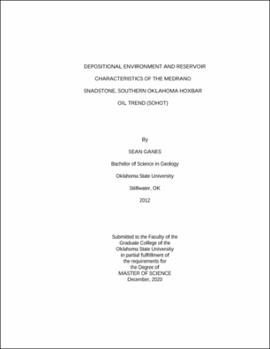| dc.contributor.advisor | Puckette, Jim | |
| dc.contributor.author | Ganes, Sean | |
| dc.date.accessioned | 2021-05-25T20:42:19Z | |
| dc.date.available | 2021-05-25T20:42:19Z | |
| dc.date.issued | 2020-12 | |
| dc.identifier.uri | https://hdl.handle.net/11244/329956 | |
| dc.description.abstract | Commercially discovered in 1936, the Medrano Sandstone, is a prolific oil and gas producer in the Cement field and surrounding areas. Deposited during Middle-Pennsylvanian time, it is a member of the Hoxbar group. The sandstone formation is located on the southwestern flank of the Anadarko basin and was most likely the sourced from the Ouachita Mountains in southeastern Oklahoma. The problem that arises when developing a field in the Southern Oklahoma Hoxbar Oil Trend (SOHOT) area with the Medrano Sandstone unit is that on conventional triple combo logs the sandstones show a strong correlation from one well to another, but taking a closer look at the reservoir using specialty NUTECH Logs, the reservoir can vary greatly. These differences (permeability, fluid saturation, etc.) in the reservoir have a direct correlation in the production of the wells. The primary objective for the study is to determine the factors that are influencing the reservoir quality of the Medrano Sandstone. | |
| dc.description.abstract | Results were based around an investigation into the depositional environment of the Medrano Sandstone, as well as an investigation into the petrology and diagenetic history of the Medrano formation. Within a predetermined geographically area public well logs, specialty NUTECH Logs, access to two cores with associated photomicrographs, SEM images, XRD, and core porosity/permeability were used to map the distribution of the Medrano sandstone and build a relationship between depositional environment and reservoir quality of the Medrano sandstone. The integrated data of core sedimentary structures and gamma-ray log motifs supported that of a prograding deltaic depositional environment, where the proposed source of the Medrano Sandstone is the Ouachita Mountains, which is supported by the major constituent of monocrystalline quartz grains and the presence of large chert grains found in core samples. Reservoir quality exhibited a relationship from structural highs of the Medrano Sandstone and also higher permeability reservoirs in the Medrano Sandstone, as determined by NUTECH Logs, are associated with distinct Electrofacies signatures of Blocky and Fining Upward log motifs. | |
| dc.format | application/pdf | |
| dc.language | en_US | |
| dc.rights | Copyright is held by the author who has granted the Oklahoma State University Library the non-exclusive right to share this material in its institutional repository. Contact Digital Library Services at lib-dls@okstate.edu or 405-744-9161 for the permission policy on the use, reproduction or distribution of this material. | |
| dc.title | Depositional environment and reservoir characteristics of the Medrano Sandstone, Southern Oklahoma Hoxbar Oil Trend (SOHOT) | |
| dc.contributor.committeeMember | Hileman, Mary | |
| dc.contributor.committeeMember | Pashin, Jack | |
| osu.filename | Ganes_okstate_0664M_16996.pdf | |
| osu.accesstype | Open Access | |
| dc.type.genre | Thesis | |
| dc.type.material | Text | |
| thesis.degree.discipline | Geology | |
| thesis.degree.grantor | Oklahoma State University | |
